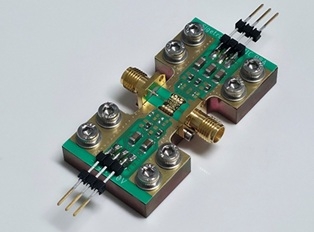News
Sigetronics Localizes GaN X-Band ICs, Targets ₩470B Market

Sigetronics X-Band Gallium Nitride Integrated Circuit Module
Specialized semiconductor device company Sigetronics (CEO Kyu-Hwan Shim) announced on the 28th that it has successfully developed a gallium nitride (GaN)-based high-frequency power amplifier monolithic microwave integrated circuit (MMIC) operating in the X-band range (8–12 GHz).
This achievement is particularly meaningful as it marks the localization of the technology using a purely domestic semiconductor fab, following technology transfer from the Electronics and Telecommunications Research Institute (ETRI).
X-band power amplifier integrated circuits are essential for strategic weapon systems such as satellite communications, missiles, and radars. In particular, within the defense sector, they are applied to core weapon systems including the KF-21 fighter jet and the next-generation Korean destroyer (KDDX), both of which are equipped with active electronically scanned array (AESA) radars.
Until now, major domestic defense companies such as Hanwha and LIG had relied on imported chips to manufacture modules and systems. However, because semiconductor chip technology is considered a strategic component subject to strict export controls by advanced countries, the need for localization had been consistently emphasized.
The chip developed by Sigetronics measures 3.2 × 2.3 mm, delivers 20W output power, achieves 40% power efficiency, and provides a 27 dB gain. According to the company, this performance is competitive with leading overseas products and can replace foreign chips in next-generation radar and satellite communication systems.
Market prospects are also highly promising. Industry sources forecast that the global GaN high-frequency integrated circuit market will grow to USD 1.25 billion next year, while the domestic market alone is estimated at ₩470 billion.
A Sigetronics official stated, “Having succeeded in developing a prototype based on a domestic fab, we will continue to closely cooperate with ETRI to establish a successful commercialization model through technology transfer from national research institutes.”
ETNews, hskim@etnews.com, August 28, 2025


